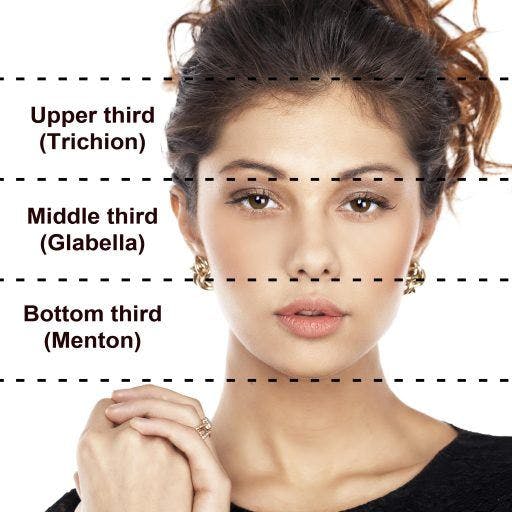How would you define a perfect face? While beauty is in the eye of the beholder, some facial characteristics are more widely celebrated than others. Society values balanced proportions and symmetry – in other words, everything the golden ratio encapsulates. So, how exactly does it work?
Here’s what you need to know about the golden ratio in relation to smile design, attractiveness, and facial harmony. Find out how a “harmonious” smile can lead to your perfect face.
The Golden Ratio in Dentistry, Smile Design, and Facial Symmetry

The golden ratio is a ratio between two numbers that equals approximately 1.618. The concept has roots in ancient Greece and can be observed everywhere in nature. In modern times, it serves as a reference point in disciplines that focus on beauty and balance. When applied to design, the ratio creates ideal and aesthetically pleasing proportions, which naturally draw the human eye.
In cosmetic dentistry and smile design
Many dental professionals use the golden ratio to guide their smile designs. They use it to determine a tooth’s optimal size, shape, and proportions, among other aesthetic qualities. Once the dentist settles on the ideal measurements for each patient, they can use those dimensions to propose appropriate treatments. As a result, the patient will have a clearer path towards a more harmonious smile.
If you have crooked teeth, your dentist may recommend clear aligners, such as ClearCorrect, to treat them. Aligners gently ease teeth into their “proper” positions to improve your overall bite, leading to a smile that better suits your face.
Award-winning dentist Dr Stephen R. Snow substantiates the idea that the golden ratio could help “develop symmetry, dominance, and proportion for aesthetically pleasing smiles.” The study analyses the six front teeth of 50 participants with “attractive smiles” and finds their average ratios to be golden ratio-compliant.
Snow assigns the following values to each tooth: 1.6 to the central, 1 to the lateral, and 0.62 to the canines (or cuspids). Their relative percentages are 25%, 16%, and 9%, respectively. In theory, a dental practitioner can apply these specific values to a patient’s teeth for that perfectly balanced smile.
In facial symmetry
One of the most well-known applications of the ratio is in assessing facial attractiveness. A quick web search will pull up hundreds of results for “beautiful celebrities” with “golden ratio faces.” You might even call it the unofficial “perfect face ratio.”
In at least one study on the golden ratio in facial symmetry, researchers found that “attractive” individuals had facial features that were in line with the golden ratio. The study concludes that “facial proportions defined by [the golden ratio] can be considered symmetrical and appealing.”
On the other hand, having a symmetrical face doesn’t always equate to universal attractiveness. In one study published in ScienceDirect, researchers found that “facial symmetry does not predict facial attractiveness independently.” The more determining factor was a face’s apparent “normality.” Put another way: symmetry doesn’t matter as much as how your features come together.
Ultimately, the golden ratio and facial symmetry are just a few measures of a beautiful appearance. They’re not the be-all and end-all of good looks. Personal preferences, among other things, still come into play. These days, more people are beginning to embrace “imperfect” or “unconventional” features – like gap teeth and wide-set eyes. There’s a greater appreciation for uniqueness, even if it’s not mathematically ideal.
Is Your Smile the Secret to Your “Perfect Face”?

Since the mouth makes up a third of your face, there’s no discounting the visual impact of a smile. So, does that mean having a harmonious (or “perfect”) smile leads to facial perfection? Not necessarily, but it can be a major factor. Here are some ways your smile affects attractiveness.
1. It contributes to a harmonious facial structure.
Since your smile is integral to your face, a well-aligned and proportional grin can enhance your overall appearance. Smiling also helps tone your facial muscles, which gives you a lifted look.
2. It gives you a bright and youthful appearance.
As you age, your face inevitably changes. Collagen production goes down, making the skin appear less supple. Dental issues, like tooth loss and gum recession, can also hollow you out. But research shows a warm, happy smile can take years off. So, while investing in your oral health now can have anti-aging effects later, it also helps to keep smiling at any age.
3. It boosts your self-confidence.
Having your ideal smile can help you be more comfortable in your skin, which does wonders for self-esteem and confidence. When you’re more confident, connecting with others, building relationships, and facing challenges with a healthy outlook become easier. As a result, you have even more reasons to smile. Smiling with confidence creates a positive cycle and can put you on a happier path.
The perfect face might be measurable in some ways, but falling short of those “ideal” characteristics shouldn’t make you doubt your beauty. Embrace your uniquely confident smile! If you’re interested in improving your teeth, don’t worry – you don’t have to jump into treatment right away. You can visit the ClearCorrect website and take this online smile assessment first to see if aligners can work for you.
References:
Prokopakis, E. P., Vlastos, I., & Picavet, V. (2013). The golden ratio in facial symmetry. Rhinology, 51(1), 18–21.
Riediger, M., Voelkle, M. C., Ebner, N. C., & Lindenberger, U. (2011). Beyond “happy, angry, or sad?”: Age-of-poser and age-of-rater effects on multi-dimensional emotion perception. Cognition & Emotion, 25(6), 968–982.
Snow, S. (1999). Esthetic Smile Analysis of Maxillary Anterior Tooth Width: The Golden Percentage. Journal of Esthetic and Restorative Dentistry, 11(4), 177–184.
Today, D. (2002, June 1). Utilizing the Concept of the Golden Proportion. Dentistry Today.
Zheng, R., Ren, D., Xie, C., Pan, J., & Zhou, G. (2021). Normality mediates the effect of symmetry on facial attractiveness. Acta Psychologica, 217, 103311.



